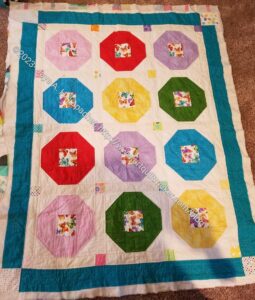
I took my Mom to Portland for her birthday last week. We spent a day in Ashland sewing with a friend. Mom worked on her hand quilting project, which is almost done.
She works on this at Craft Night. Isn’t it cheerful?
Commentary about works in progress, design & creativity
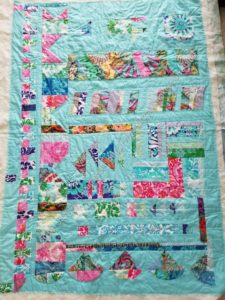
I am a little sick of the Half Hexie Star project, so I switched to Big Stitching the BAMQG IRR. It never ceases to amaze me how much progress I make when I actually work on a project. It has been awhile since I worked on it and it is a nice break from EPP.
I had to get back in the Big Stitch groove, which was difficult. I finally figured out that I couldn’t do it when I was stitching in a seam allowance, because of all the layers. That means I am doing some stab stitching in addition to the Big Stitch.
One of the challenges I have is what quilting designs to use. Right now I am just echo quilting. I don’t know if I want to do more, if curves will work with Big Stitch or if there are other designs I should use. I haven’t handquilted a lot. When I have done it I have mostly used echo quilting to highlight the block designs. Occasionally, I have used stencils. I’ll have to look at some books and see if I can get inspired.
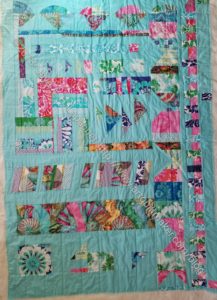
I made some progress on the BAMaQG IRR at Craft Night the other night. The image shows the whole piece. Obviously, you can’t see the hand stitching, but you can get an overall view of the piece.
I am not using a pattern or marking much when I Big Stitch. I am following the stitching lines and eyeballing where my stitches go. They are mostly straight lines, a quarter inch from seams.
I plan to use different threads, especially the Sue Spargo threads I have been buying, but at the moment I am using an Aurifil embroidery thread.
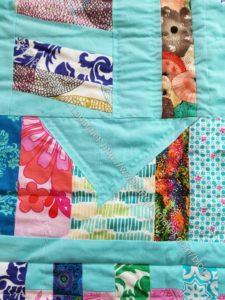
The Flying Geese made some arrow type designs.
You can see, especially if you click on the image to make it larger, that I am doing multiple rows of outline stitching. I don’t want the piece to be stiff, so I probably won’t fill in the whole arrow, but I might do a few more lines. I’ll have to see.
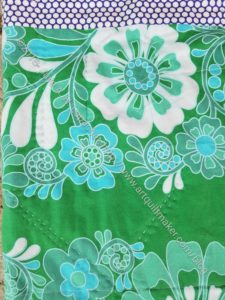
I am pretty pleased with the way the back looks as well. Unlike 10 stitches to the inch hand quilting, the stitches on the back of a Big Stitched quilt are supposed to be smaller, according to Sarah Fielke. Mine are smaller and even, which is what I have been working to improve.

If I were to put stitches in all the solid areas so there was no open space, the look would be somewhat like one section I already did. The section between the green dots and blue flowers has about 4 lines of stitching that covers the whole area.
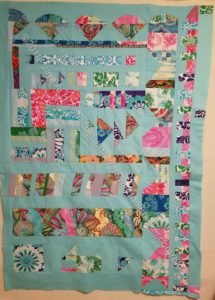
The top is finished and I am on to putting together the back. I don’t think I will make my deadline of having this ready for Big Stitching, but I have made great progress and see the light at the end of the tunnel.
There is much more space and lightness in the piece and the solid areas will provide some good spaces for stitching.
A few weeks ago I wrote a blog post about Saral Transfer Paper. Frances mentioned it on her podcast (Episode 96), but still seemed unsure, so I thought I would write about the other tools I use for quilting (sewing 3 layers together not making an entire quilt).
I am liking the Saral Transfer Paper as I work on the whole cloth quilt. It does come off easily, so I have to darken the lines a bit as I move through the quilting process, but that is ok with me.
I don’t think it is possible, at least I have not found a way to mark and entire quilt and keep the markings on through the entire quilting process. If I want special designs, I will draw them on one block at a time with one of the 3 methods that work for me. Yes, this can be a bit annoying, but it is good excuse for me to stop, take a rest and stretch.

I use other tools for marking.
I am not much of a quilter. I send most of my quilts out, but every now and then I get a wild hair (as Pam says) every once in a while and quilt a quilt. The Nonce pencil is a little hard and flaky. It is easier to use on a hard surface (e.g. NOT fabric), but that doesn’t really work for me. I use it with stencils. It works on most colors except for the very light ones.
The Roxanne pencil is much softer and works for a lot of colors from light to dark. I use this for lighter fabrics. Sometimes it doesn’t show up on the mid-range colors.
I have been using the Sewline pencils, primarily, to darken the Saral lines that have faded a bit. I could use this tool for marking a whole quilt as well, but I would need a stencil or a good idea in my mind and confidence. This works for me.
The Chalkoner is also good for darkening up lines right before you quilt them.
I mostly do not wash my quilts, so washing out paper or whatever isn’t an option. It also makes my head hurt to think about the damage to my washer. I have enough handwork and don’t want to use tweezers enough, so I would avoid sewing over paper.
I have always been afraid of the blue washaway pens, so I haven’t tried them. I haven’t tried the Dritz paper and I am allergic to everything so try and minimize chemically smells in my house. I don’t use Pounce either, because I want to avoid particles floating around the air. I am concerned about the Glad Press & Seal method, but I don’t know anything about it, so will have to reserve judgment.